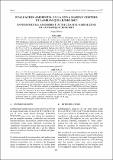Por favor, use este identificador para citar o enlazar este ítem:
https://hdl.handle.net/20.500.12958/3492| Título : | Evaluación ambiental en la zona marino costera de Lambayeque (junio 2017) |
| Otros títulos : | Environmental assessment in the coastal marine zone of Lambayeque (June 2017) |
| Autor : | Bances, Sergio |
| Palabras clave : | Zona Marino Costera;Lambayeque |
| Fecha de publicación : | 2020 |
| Editorial : | Instituto del Mar del Perú |
| Citación : | Bol Inst Mar Perú. 35(2) 2020, p. 335-351 |
| Citación : | Boletín Imarpe;35(2), 2020 |
| Resumen : | La zona marino costera de Lambayeque comprende desde la desembocadura del Dren
1000 (Bodegones) hasta la desembocadura del río Zaña. En junio 2017 se realizó un estudio del inter y
submareal con el objetivo de evaluar la calidad ambiental de las aguas a partir de indicadores fisicoquímicos y oceanográficos. El rango de temperaturas fue de 17,6 a 24,1 °C, las anomalías térmicas positivas variaron de +3,7 a + 6,0 °C. La salinidad superficial fluctuó entre 34,149 y 35,245; en el intermareal fueron menores los valores debido a la influencia de las descargas de los ríos de la Región. El oxígeno disuelto varió entre
2,20 y 9,73 mg/L. El potencial de Hidrógeno fluctuó entre 7,77 a 8,30. En el submareal, la contaminación fecal no sobrepasó 2 NMP/100 mL para Coliformes Totales (CT) y Coliformes Termotolerantes (CTT), en el intermareal los CT fluctuaron entre <1,8 y 2,2x104 NMP/100 mL, y los CTT entre <1.8 y 1,4x104 NMP/100 mL. Los nutrientes (fosfatos, silicatos, nitritos y nitratos) se incrementaron en comparación con la prospección de mayo-junio 2016 originado por el caudal de los ríos que desembocaron en la zona marina costera. El cobre en sedimento varió de <0,030 a 6,91 μg/g, el zinc de 19,59 a 38,4 μg/g, y el plomo de 2,50 a 5,41 μg/g. El cadmio varió de <0,020 a 1,14 μg/g. ABSTRACT: The coastal marine zone of Lambayeque extends from the mouth of the Drain 1000 (Bodegones) to the mouth of the Zaña River. In June 2017, we conducted a study of the intertidal and subtidal areas to evaluate the environmental quality of the waters based on physicochemical and oceanographic indicators. The temperature range was from 17.6 to 24.1 °C, positive thermal anomalies varied from +3.7 to + 6.0 °C. The surface salinity fluctuated between 34.149 and 35.245; in the intertidal, the values were lower due to the influence of the discharges of the rivers of the Region. Dissolved oxygen varied from 2.20 to 9.73 mg/L. pH ranged from 7.77 to 8.30. In the subtidal, fecal pollution did not exceed 2 NMP/100 mL for Total Coliforms (TC) and Thermotolerant Coliforms (TTC), in the intertidal TC fluctuated between <1.8 and 2.2x104 NMP/100 mL, and TTC between <1.8 and 1.4x104 NMP/100 mL. Nutrients (phosphates, silicates, nitrites, and nitrates) increased when compared to the survey of May-June 2016, originated by the rivers that flowed into the coastal marine zone. Copper in sediment ranged from <0.030 to 6.91 μg/g, zinc from 19.59 to 38.4 μg/g, and lead from 2.50 to 5.41 μg/g. Cadmium varied from <0.020 to 1.14 μg/g. |
| URI : | https://hdl.handle.net/20.500.12958/3492 |
| ISSN : | 04587766 |
| Aparece en las colecciones: | Boletín 35(2), 2020 |
Ficheros en este ítem:
| Fichero | Descripción | Tamaño | Formato | |
|---|---|---|---|---|
| Bol 35(2)-9.pdf | 6,35 MB | Adobe PDF |  Visualizar/Abrir |
Este ítem está sujeto a una licencia Creative Commons Licencia Creative Commons

